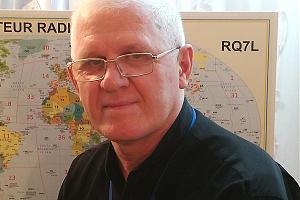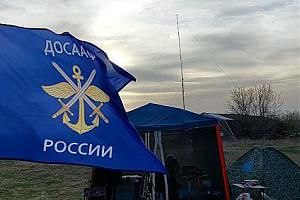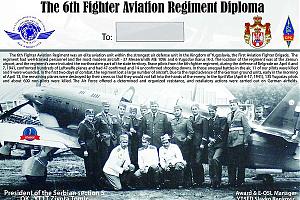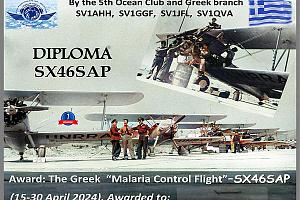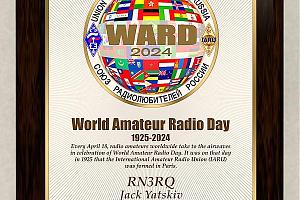ANS is a free, weekly, news and information service of AMSAT North America, the Radio Amateur Satellite Corporation. ANS reports on the activities of a worldwide group of Amateur Radio operators who share an active interest in designing, building, launching and communicating through analog and digital Amateur Radio satellites.
ANS is first released via the AMSAT-NA 20-meter net held each Sunday on 14.282 MHz. Pre-net operations start at 18:00 UTC, with current ANS bulletins transmitted to the western U.S. at 19:00 UTC and to the eastern U.S. at 19:30 UTC. ANS is also released worldwide via the AMSAT ANS e-mail reflector.
AMSAT-NA is pleased to announce that recent and future development in Amateur Radio satellites will take place in Atlanta, Georgia at the 19th Space Symposium and AMSAT-NA Annual Meeting. Stay tuned to ANS for date, agenda and other details on the 2001 Symposium!
Information on AMSAT-NA is available at the following URL:
http://www.amsat.org (or from)
AMSAT-NA 850 Sligo Avenue, Suite 600 Silver Spring, Maryland 20910-4703
Voice: 301-589-6062 FAX: 301-608-3410
Currently, AMSAT-NA supports the following (free) mailing lists:
* AMSAT News Service (ANS) * General satellite discussion (AMSAT-BB) * Orbit data (KEPS) * Manned space missions (SAREX) * District of Columbia area (AMSAT-DC) * New England area (AMSAT-NE) * AMSAT Educational Liaison mailing list (AMSAT-EDU) * AMSAT K-12 Educational Liaison mailing list (AMSAT-K12)
A daily digest version is available for each list.
To subscribe, or for more list information, visit the following URL:
http://www.amsat.org/amsat/listserv/menu.html
This edition of ANS is dedicated to the memory of Piero Moroni, I5TDJ, a well-known figure in the moonbounce community, who died November 14th after a lengthy illness. He was 66. An electronic engineer, he had been licensed since 1952 and had been active in EME work since the mid-1970s, operating mainly on 432 MHz. [ANS thanks the ARRL for this information]
ANS is also dedicated to the memory of past ANS editor 'BJ' Arts, WT0N, and to the memory of long-time AMSAT supporter Werner Haas, DJ5KQ.
SB SAT @ AMSAT $ANS-331.01 PHASE 3D/AO-40 UPDATE
AMSAT NEWS SERVICE BULLETIN 331.01 FROM AMSAT HQ SILVER SPRING, MD, NOVEMBER 26, 2000 TO ALL RADIO AMATEURS BID: $ANS-331.01
As previously announced in ANS-327.01, AO-40 command stations have been quite busy lately as general housekeeping tasks have been underway to verify the health of the many complex systems onboard AMSAT OSCAR-40 - all with very good results.
P3D Project leader Dr. Karl Meinzer, DJ4ZC, informed ANS that following the successful launch and injection into nominal orbit, initial telemetry from the satellite was expected on 70-cm at about the 3-hour mission mark. This did not happen and consequently the spacecraft was switched to use the 144 MHz middle beacon as the main telemetry downlink. This required a new program to be uploaded into P3D's IHU-2 system.
After new software, communication was established and the health of AO-40 was analyzed and tested. DJ4ZC happily reported "except for the UHF transmitter, everything was found to be nominal and working fine." The attitude control system was then calibrated and torque reorientation operations started, which are still underway. Both 2400 MHz transmitters were successfully operated and pictures from the separation sequence are now being downloaded and will posted on the AMSAT-DL web site. Currently, there are photos and a separation sequence of the conical adapter (which was above P3D) just before Phase 3D was released. View this information at:
http://www.amsat-dl.org/
The first planned orbit change will soon take place and that should result in a 50,000 km apogee. This will allow a thorough study of the 70-cm transmitter problem using P3D's hi-gain antennas (which) would then be available.
After the first orbit change is completed a test the electric propulsion Arcjet system will take place (and) if successful, it will be used to further increase the apogee of AO-40.
AMSAT-NA President Robin Haighton, VE3FRH, told ANS that "plans are in place to make AO-40 available for a limited period of general Amateur Radio use possibly within a week or two." This provisional operation would involve "one or two bands at a time," said VE3FRH. Details of the limited test period will be announced by an official AMSAT ANS bulletin and via the AO-40 telemetry beacon.
Currently, AO-40 is downlinking data on the V-band omni-directional antenna located on the bottom of the spacecraft. The V-band transmitter is at 50 watts (and is adjustable). The spacecraft is spinning, which is necessary for the use of the 400N bi-propellant engine. However, spinning reduces the total solar power available. Substantially more solar power will be available after AO-40 reached its final orbit configuration and the solar panels are deployed.
North American P3D Command Station operator Stacey Mills, W4SM, has placed a zip file containing his P3D telemetry decoding program (P3T.exe) as well as some additional supporting files on his web page. The program will run on Windows 95/98/NT/2000 platforms. W4SM reports additional programs are under development for Mac and Linux platforms. The information is available at:
http://www.amsat-dl.org/p3d/
IZ8BLY recently released an AO-40 telemetry decoding program. It is available at:
http://iz8bly.sysonline.it/P3D/index.htm
The complete Phase 3-D frequency band plan is available at:
http://www.amsat-dl.org/p3dqrg.html
Stay tuned to ANS for additional bulletins from AMSAT, the official source of information on the Phase 3D satellite.
[ANS thanks AMSAT-DL, AMSAT-NA and the ARRL for this information]
/EX
SB SAT @ AMSAT $ANS-331.02 THE PRESIDENT'S LETTER
HR AMSAT NEWS SERVICE BULLETIN 331.02 FROM AMSAT HQ SILVER SPRING, MD, NOVEMBER 26, 2000 TO ALL RADIO AMATEURS BID: $ANS-331.02
ANS is pleased to introduce a new feature - the President's Letter. The letter is authored by AMSAT-NA President Robin Haighton, VE3FRH. At this time ANS is planning to run this feature on a monthly basis.
To all AMSAT-NA Members,
Following the very successful launch of P3D and it's conversion to AO-40, I have followed the commissioning of the Satellite with a great deal of interest, and from the reports that I see on the AMSAT-BB and elsewhere, so have many of you. Naturally there is a desire to get as much information as possible on the status of the bird and I encourage you to follow the commissioning sequence with available telemetry programs.
Bulletins and pictures are available on the AMSAT-DL web site and bulletins are also placed on the AMSAT-NA web site. As you are no doubt aware, the controllers of the satellite are working to commission AO-40 and nearly all is going to plan. Our only apparent problem is the U-band/70cm transmitter. At this time the reason for the failure is not known, but as we progress with the commissioning, it is possible that a solution may be found.
I have talked at length with the P3D Project Director Karl Meinzer, DJ4ZC, about issuing regular bulletins about AO-40 -- and although we both realize that it would be wonderful to do this it is important to note that there will be periods of time when the best we could report would be 'no significant change'. It may be two weeks or more between significant events, therefore, status updates two or three times a week are just not practical.
Rest assured that any significant change will be reported to you by the AMSAT News Service (ANS) bulletins just as fast as possible, and by our volunteers.
So far from the received telemetry, all indications are that AO-40 will be a wonderful satellite and will provide many years of service to the Amateur Radio community. Between now and when we achieve final orbit, all of us have a great opportunity to set up and check out our stations with the equipment needed to work the satellite. Sources for information include the many articles in the AMSAT Journal and the many other Amateur Radio magazines, as well as the various AMSAT publications available from Martha at the AMSAT-NA office.
Best regards,
Robin Haighton, VE3FRH, President AMSAT-NA
[ANS thanks AMSAT-NA President Robin Haighton, VE3FRH, for this information]
/EX
SB SAT @ AMSAT $ANS-331.03 ARISS UPDATE
HR AMSAT NEWS SERVICE BULLETIN 331.03 FROM AMSAT HQ SILVER SPRING, MD, NOVEMBER 26, 2000 TO ALL RADIO AMATEURS BID: $ANS-331.03
ARISS spokesman Will Marchant, KC6ROL, reports to ANS that International Space Station commander William 'Shep' Shepherd, KD5GSL, has been able to take a few minutes out of his busy schedule to start general QSO's with the international ham community.
With the recent arrival of a Progress automated cargo craft, the crew's work pace will redouble. In addition, with the planned launch of STS-97 to ISS on November 30th, the Expedition-1 crew will be working long hours to prepare for the arrival of space shuttle Endeavor. The shuttle will carry a large solar panel for ISS.
The planning for school operations is actively underway, and efforts are being made to have the first several school contacts before the end of the year. It is hoped that several school contacts can be accommodated each month, but the crew will be exceedingly busy and everyone must be prepared to support more, or possibly, fewer school contacts. The initial schools have been contacted and efforts are underway to finalize the details of their contacts.
The ARISS organization is beginning to accept applications for school contacts; however, the crew workload will determine the amount of time that passes between accepting an application and when a contact is scheduled. The ARISS team is asking that we remember these are very early times for the ISS and we need to remain flexible in pursuing Amateur Radio operations with the crews.
More information about Amateur Radio on the ISS is available at the http://ariss.gsfc.nasa.gov/ web pages.
[ANS thanks the ARISS team, Will Marchant, KC6ROL, and the ARRL for this information]
/EX
SB SAT @ AMSAT $ANS-331.04 AO-27 INTERFERENCE
HR AMSAT NEWS SERVICE BULLETIN 331.04 FROM AMSAT HQ SILVER SPRING, MD, NOVEMBER 26, 2000 TO ALL RADIO AMATEURS BID: $ANS-331.04
AMSAT-NA Executive Vice President Ray Soifer, W2RS, reported to ANS that Martin Potter, VE3OAT, has provided an update on the AO-27 non-amateur interference situation. VE3OAT is the IARU Region-2 Monitoring Service coordinator.
The good news is (according to XE2BSS who is covering the problem in Mexico) the original source of interference to the AO-27 uplink has now been identified and that source has stopped transmitting. The interference was being generated by a taxi fleet not licensed to use equipment operating on 144 MHz.
Severe interference from other allegedly unlicensed Spanish-speaking stations is continuing however, not only on 145.850 but also on 145.825 MHz. These transmissions are also being picked up by UO-14 and SO-35.
The investigation into these interference sources continues.
[ANS thanks AMSAT-NA Executive Vice President Ray Soifer, W2RS, for this information]
/EX
SB SAT @ AMSAT $ANS-331.05 MIR TO BE DE-ORBITED
HR AMSAT NEWS SERVICE BULLETIN 331.05 FROM AMSAT HQ SILVER SPRING, MD, NOVEMBER 26, 2000 TO ALL RADIO AMATEURS BID: $ANS-331.05
Several news agencies are reporting the Mir space station will be ditched this coming February in a controlled descent that will send it hurtling into a remote area of the Pacific Ocean.
The Russian government had decided to abandon the Mir earlier this year, but then extended its lifetime after a private company promised to pay for its operation.
Currently, there is no human habitation aboard the station and the onboard Amateur Radio equipment has been turned off.
Mir continues on 'autopilot'.
[ANS thanks Florida Today for this information]
/EX
SB SAT @ AMSAT $ANS-331.06 ANS IN BRIEF
HR AMSAT NEWS SERVICE BULLETIN 331.06 FROM AMSAT HQ SILVER SPRING, MD, NOVEMBER 26, 2000 TO ALL RADIO AMATEURS BID: $ANS-331.06
ANS news in brief this week includes the following:
** The Experimenters Group Amateur Radio Club in Greenville, South Carolina, will celebrate the arrival of the Expedition-1 crew aboard ISS with special event station N4ISS on December 2-3rd. Operation of N4ISS will be on or about 7.297, 14.297, and 28.497 MHz (along with AO-27). A certificate will be available. For more information, contact KD4SFF, at kd4sff@amsat.org. -ANS/ARRL
** Kazakhstan is prepared to extend Russia's lease on the Baikonur Cosmodrome for another ten years. The announcement came at a news briefing held at Baikonur on recently. -SpaceDaily
** Nominations are open for the ARRL 2000 Technical Service award. The award goes each year to a radio amateur whose service to the amateur community and/or society at large is of the most exemplary nature within the framework of Amateur Radio technical activities; such as leadership and service. Nominations must be received by March 31, 2001. For more information, contact Jean Wolfgang, WB3IOS, at jwolfgang@arrl.org. -ARRL
** Since the mid-1970s, El Nino events are recurring about three times more often than they did in the mid-19th century, judging from satellite analysis by two University of Arizona geologists. -SpaceDaily
** Jim, K6CCC, has placed recordings of several FM satellite passes (from his station in Los Angeles) on his web site. Check out the recordings at http://home.earthlink.net/~k6ccc/. -ANS
** John, N8QGC, will be active December 4-11th from the Grand Cayman Islands (EK99) and Kingston Jamaica (FK28) on UO14 and AO27 -- using the callsigns ZF2SE and N8QGC/6Y5. -Bruce, KK5DO
** Willems, ON1CAU, repots to ANS that he has updated his web page page (http://users.skynet.be/on1cau/) with information on AO-40. Claudio, IK1SLD, upgraded his web site with an image sequence of the Phase 3D launch at http://www.ik1sld.org/phase3d_launch.htm. -ANS
** How can a future space shuttle mission to ISS lead to a better treatment for diseases? Mississippi State University, working with NASA, have discovered that gravity may be the key. Check out the story at: http://www.spacedaily.com/news/spacemedicine-00h.html. -SpaceDaily
** Jerry, K5OE, noted increased activity on AO-10 recently and many stations have noted to K5OE that they have not been on in a long time (many since AO-13 days). Jerry is calling this the 'AO-40 effect' and he reports this as being very positive. ANS could not agree more! -NN0DJ
** Ronald Ross, KE6JAB, is in Antarctica again and sending text and photos back from the Blue 1 Base in Antarctica via UO-22 satellite. To view this operation, look at http://www.thistle.org. -Roy, W0SL
--ANS BULLETIN END---
/EX
SB SAT @ AMSAT $ANS-331.07 WEEKLY SATELLITE REPORT PART 1
AMSAT NEWS SERVICE BULLETIN 331.07 FROM AMSAT HQ SILVER SPRING, MD, NOVEMBER 26, 2000 TO ALL RADIO AMATEURS BT BID: $ANS-331.07
Phase 3D / AMSAT OSCAR 40 / AO-40 Beacon: 145.898 MHz Launched: November 16, 2000 aboard an Ariane 5 launcher from Kourou, French Guiana. A 50-second video of the launch can be seen at: http://arianespace.com/interior/v135better.mov
Status: Initial commissioning and housekeeping tasks underway
Uplink/downlink frequency plan: http://www.amsat-dl.org/p3dqrg.html
P3D Project leader Dr. Karl Meinzer, DJ4ZC, informed ANS that following the successful launch and injection into nominal orbit, "except for the UHF transmitter, everything was found to be nominal and working fine."
Although safely in orbit, there is much work to be done with Phase 3D before the satellite is opened for general Amateur Radio use. Initial housekeeping tasks are now underway to verify the health of the many complex systems onboard - followed by bringing these systems online. Currently, AO-40 is downlinking data on the V-band omni-directional antenna located on the bottom of the spacecraft. The V-band beacon is currently transmitting PSK telemetry on MHz. "P3D is loud," reported ANS principal satellite investigator N1JEZ, "even at apogee signals at my QTH are S-9 or better with no detectable QSB." Both S-band transmitters have been tested and both have been found to work properly.
North American P3D Command Station operator Stacey Mills, W4SM, has placed a zip file containing his P3D telemetry decoding program (P3T.exe) as well as some additional supporting files on his web page. The program will run on Windows 95/98/NT/2000 platforms. W4SM reports additional programs are under development for Mac and Linux platforms. The information is available at:
http://www.amsat-dl.org/p3d/
IZ8BLY recently released an AO-40 telemetry decoding program. It is available at:
http://iz8bly.sysonline.it/P3D/index.htm
[ANS thanks AMSAT-NA and AMSAT-DL for this information]
INTERNATIONAL SPACE STATION/ARISS Worldwide packet uplink: 145.990 MHz Region 1 voice uplink: 145.200 MHz Region 2/3 voice uplink: 144.490 MHz Worldwide downlink: 145.800 MHz TNC callsign RZ3DZR ARISS initial station launched September 2000 aboard shuttle Atlantis Status: Operational (although current ISS workload is limiting operation)
ARISS team member Will Marchant, KC6ROL, reported to ANS that the crew is exceedingly busy, limiting the amount of time the ISS crew has for ham activities.
Planning for the deployment and use of the ham system aboard ISS has been an international effort coordinated by NASA's Goddard Space Flight Center. The effort began in 1996 with the formation of the Amateur Radio International Space Station organization. ARISS is made up of delegates from major national amateur radio organizations, including AMSAT.
Two U.S. callsigns have recently been issued for Amateur Radio operations with ISS. The FCC granted vanity callsigns NA1SS and NN1SS to the International Space Station Amateur Radio Club in mid-October. The NA1SS callsign will be used aboard ISS, and NN1SS will be used for ground-based transmissions from the Goddard Space Flight Center. Russian callsign RZ3DZR and German call sign DL0ISS have previously been issued for use aboard the station. The crew may use their own callsigns (KD5GSL, U5MIR) or they may use one of the ISS calls. RZ3DZR is also the callsign entered into the TNC currently onboard Alpha.
More information about the project can be found on the ARISS web site at http://ariss.gsfc.nasa.gov.
[ANS thanks ARISS team member Will Marchant, KC6ROL, for this information]
RADIO SPORT RS-13 Uplink 21.260 to 21.300 MHz CW/SSB Downlink 29.460 to 29.500 MHz CW/SSB Downlink 145.860 to 145.900 MHz CW/SSB Beacon 145.863 MHz Launched: February 5, 1991 aboard a Russian Cosmos C launcher Status: Operational, mode T
RS-13 apparently has (apparently) been switched to mode-T recently. In addition, several stations have also reported that the 29.408 MHz RS-12 beacon has also recently been activated. The beacon telemetry indicated that both the 10 and 2-meter receivers aboard RS-12 are currently off.
Tony, AB2CJ, reports working the RS-13 CW robot recently with good signals.
More information about RS-12 and RS-13 can be found on the AC5DK RS-12/13 Satellite Operators page at:
http://www.qsl.net/ac5dk/rs1213/rs1213.html
[ANS thanks Kevin Manzer, AC5DK, for this information]
RADIO SPORT RS-15 Uplink 145.858 to 145.898 MHz CW/SSB Downlink 29.354 to 29.394 MHz CW/SSB Beacon 29.352 MHz (intermittent) SSB meeting frequency 29.380 MHz (unofficial) Launched: December 26, 1994 from the Baikonur Cosmodrome Status: Semi-operational, mode-A, using a 2-meter uplink and a 10-meter downlink
Dave, WB6LLO, has operating information for both RS-15 (and RS-13) on his web site. In addition to satellite data, antenna information for mode-A operation is also featured. The WB6LLO web site URL is:
http://home.san.rr.com/doguimont/uploads
[ANS thanks Dave Guimont, WB6LLO, for this information]
OSCAR 10 AO-10 Uplink 435.030 to 435.180 MHz CW/LSB Downlink 145.975 to 145.825 MHz CW/USB Beacon 145.810 MHz (unmodulated carrier) Launched: June 16, 1983 by an Ariane launcher from Kourou, French Guiana Status: Semi-operational, mode-B. AO-10 has been locked into a 70-cm uplink and a 2-meter downlink for several years
DX continues to be worked (and heard) on AO-10. John, K6YK, reports JA6BX, FO5QS, PY4AJ, LU8MB, TF3MLT, CT1DOP, ZL2VBV, LU1VD, KP3A, EA6LT, EA8/DJ9PC and PY3BZM have been active along with many U.S. stations heard/worked during the week. Jerry, K5OE, reports lots of DX recently including LU, F, I, G, PA and PE stations. "QSB was mild and signals were strong," said K5OE.
W4SM has more information about the satellite at the following URL:
http://www.cstone.net/~w4sm/AO-10.html
[ANS thanks Stacey Mills, W4SM, for his AO-10 status information and web site]
AMRAD AO-27 Uplink 145.850 MHz FM Downlink 436.795 MHz FM Launched: September 26, 1993 by an Ariane launcher from Kourou, French Guiana Status: Operational, mode J
Periodically, AO-27's analog repeater will be turned off for a few days at a time to enable ground controllers to gather Whole Orbital Data (WOD), to verify the health of the satellite.
An AO-27 question-and-answer page is available on the AMSAT-NA web site. The URL is: http://www.amsat.org/amsat/intro/ao27faq.html.
AO-27 uses a method called Timed Eclipse Power Regulation (TEPR) to regulate the on-board batteries. In simple terms, TEPR times how long the satellite has been in an eclipse (or in the sun) and decides what subsystems to turn on or off. The current TEPR settings (as of November 25, 2000) are:
TEPR 4 18 TEPR 5 36
The AO-27 pages on the AMSAT-NA web site include an explanation of TEPR AO-27 operations (at):
http://www.amsat.org/amsat/sats/n7hpr/ao27.html
[ANS thanks AMRAD for AO-27 information]
UO-14 Uplink 145.975 MHz FM Downlink 435.070 MHz FM Launched: January 22, 1990 by an Ariane launcher from Kourou, French Guiana Status: Operational, mode J
John, K6YK, reports recent UO-14 activity includes K5ATM on a grid expedition to Montana/North Dakota, N0ZHE/mobile in Kansas and Oklahoma and KD5FBA in south Texas.
Tim, KG8OC, has updated the Michigan AMSAT Information site to include UO-14 information -- point your web browser to the following URL:
http://www.qsl.net/kg8oc
[ANS thanks Chris Jackson, G7UPN/ZL2TPO, for UO-14 information]
SUNSAT SO-35 Mode J Uplink: 145.825 MHz FM Mode J Downlink: 436.250 MHz FM
Mode B Uplink: 436.291 MHz FM Mode B Downlink: 145.825 MHz FM Launched: February 23, 1999 by a Delta II rocket from Vandenberg Air Force Base in California Status: Operational.
SunSat is currently transmitting a greeting to AO-40:
'Greetings AMSAT OSCAR-40, 73 from SunSat OSCAR-35'
The SunSat package includes 1200 and 9600 baud digital store-and-forward capability and a voice 'parrot' repeater system that will be used primarily for educational demonstrations in addition to Mode B/J operation. The satellite has two VHF and two UHF transmit-receive systems.
For more information on SunSat, visit the following URL:
http://sunsat.ee.sun.ac.za
A summary of the active modes and frequency allocations for SunSat is available at the following URL:
http://esl.ee.sun.ac.za/~lochner/sunsat/modes.html
[ANS thanks Garth Milne, ZR1AFH, for this information]
JAS-1b FO-20 Uplink 145.90 to 146.00 MHz CW/LSB Downlink 435.80 to 435.90 MHz CW/USB Launched: February 07, 1990 by an H1 launcher from the Tanegashima Space Center in Japan Status: Operational. FO-20 is in mode JA continuously
Tak, JA2PKI, reported the FO-20 control station operators believe that the UVC (Under Voltage Controller) now is regulating the transponder. The UVC monitors battery voltage and tries to protect the batteries from over discharge. Tak notes that FO-20, launched in 1990, is now over 10 years old.
[ANS thanks Kazu Sakamoto, JJ1WTK, for the FO-20 status reports]
JAS-2 FO-29 Launched: August 17, 1996, by an H-2 launcher from the Tanegashima Space Center in Japan Status: Operational
Voice/CW Mode JA Uplink 145.90 to 146.00 MHz CW/LSB Downlink 435.80 to 435.90 MHz CW/USB
Digital Mode JD Uplink 145.850 145.870 145.910 MHz FM Downlink 435.910 MHz 1200 baud BPSK or 9600 baud FSK Callsign 8J1JCS Digitalker 435.910 MHz
The JARL FO-29 command station has announced the following operation schedule of FO-29:
Nov. 27 - Dec. 7th JA The schedule showed JD 1200 baud digital operation before November 27th, but the satellite remained in mode JA.
Mike, KF4FDJ, has put together a very informative document on FO-29, addressing the analog, digital and digi-talker modes. To obtain a copy e-mail Mike at: kf4fdj@amsat.org.
Mineo, JE9PEL, has a FO-29 satellite telemetry analysis program that will automatically analyze all digital telemetry from the satellite (such as current, voltage and temperature). The JE9PEL FO-29/shareware is available at the following URL:
http://www.ne.jp/asahi/hamradio/je9pel/
[ANS thanks Kazu Sakamoto, JJ1WTK, for the FO-29 status reports]
SAUDISAT-1A Uplink to be released Downlink 437.075 MHz Broadcast Callsign SASAT1-11 BBS SASAT1-12 Launched: September 26, 2000 aboard a converted Soviet ballistic missile from the Baikonur Cosmodrome Status: Commissioning stage, initial housekeeping tasks underway
SaudiSat-1A will operate as 9600 baud digital store-and-forward systems as well analog FM repeater mode capability. One of two new ham satellites from the Kingdom of Saudi Arabia built by the Space Research Institute at the King Abdulaziz City for Science and Technology.
SAUDISAT-1B Uplink to be released Downlink 436.775 MHz Broadcast Callsign SASAT2-11 BBS SASAT2-12 Launched: September 26, 2000 aboard a converted Soviet ballistic missile from the Baikonur Cosmodrome Status: Commissioning stage, initial housekeeping tasks underway
SaudiSat-1B will operate as 9600 baud digital store-and-forward systems as well analog FM repeater mode capability. One of two new ham satellites from the Kingdom of Saudi Arabia built by the Space Research Institute at the King Abdulaziz City for Science and Technology.
/EX
SB SAT @ AMSAT $ANS-331.08 WEEKLY SATELLITE REPORT PART 2
AMSAT NEWS SERVICE BULLETIN 331.08 FROM AMSAT HQ SILVER SPRING, MD, NOVEMBER 26, 2000 TO ALL RADIO AMATEURS BT BID: $ANS-331.08
TIUNGSAT-1 Uplink 145.850 or 145.925 MHz 9600 baud FSK Downlink 437.325 MHz Broadcast callsign MYSAT3-11 BBS MYSAT3-12 NUP MYSAT3-10 Launched: September 26, 2000 aboard a converted Soviet ballistic missile from the Baikonur Cosmodrome Status: Operational in digital mode, currently at 9600 baud FSK
TiungSat-1 is Malaysia's first micro-satellite and in addition to commercial land and weather imaging payloads offers FM and FSK Amateur Radio communication.
TiungSat-1, named after the mynah bird of Malaysia, was developed as a collaborative effort between the Malaysian government and Surrey Satellite Technology Ltd.
For more information on TiungSat-1, visit the following URL:
http://www.yellowpages.com.my/tiungsat/tiung_main.htm
[ANS thanks Chris Jackson, G7UPN/ZL2TPO, for this information]
KITSAT KO-25 Uplink 145.980 MHz FM (9600 baud FSK) Downlink 436.500 MHz FM Broadcast Callsign HL02-11 BBS HL02-12 Launched: September 26, 1993 by an Ariane launcher from Kourou, French Guiana Status: Operational
Jim, AA7KC, now reports nominal KO-25 operation, with traffic increased to a moderate level.
[ANS thanks Jim Weisenberger, AA7KC, for KO-25 status information]
UOSAT UO-22 Uplink 145.900 or 145.975 MHz FM 9600 baud FSK Downlink 435.120 MHz FM Broadcast Callsign UOSAT5-11 BBS UOSAT5-12 Launched: July 17, 1991 by an Ariane launcher from Kourou, French Guiana Status: Operational
Jim, AA7KC, reports nominal UO-22 operation with heavy traffic and continuing major sat-gate operation.
More information on the satellite is available at the following URL:
http://www.sstl.co.uk/
[ANS thanks Chris Jackson, G7UPN/ZL2TPO, for UO-22 status information]
OSCAR-11 Downlink 145.825 MHz FM (1200 baud AFSK) Mode-S Beacon 2401.500 MHz Launched: March 1, 1984 by a Delta-Thor rocket from Vandenberg Air Force Base in California Status: Operational
OSCAR-11 celebrated its sixteenth birthday in space on March 1, 2000.
During the period through November 14, 2000 good signals have been received from the 145 MHz beacon as the satellite is currently seeing good solar conditions which should continue until the end of the year. Ground control stations have reset the magnetorquer counters, the spin period has varied between 217 and 276 seconds. The battery voltage observed during daylight passes is unchanged with an average value of 14.0, with a range of 13.9 to 14.1 volts. Internal temperatures have increased slightly and are probably near maximum value. They are now 6.6 C and 4.8 C for battery and telemetry electronics. A single WOD survey of dated 06-October-2000, has been transmitted. The mode-S beacon is transmitting an unmodulated carrier. The beacon is a useful test source for mode-S converters. The 435.025 MHz beacon is normally off but can sometimes be heard when the satellite is being commanded by ground control.
The operating schedule is as follows:
ASCII status (210 seconds) ASCII bulletin (60 seconds) BINARY SEU (30 seconds) ASCII TLM (90 seconds) ASCII WOD (120 seconds) ASCII bulletin (60 seconds) BINARY ENG (30 seconds)
The ASCII bulletin is currently a static message, detailing modes and frequencies of all active amateur radio satellites.
More information on OSCAR-11 is available at the following URL:
http://www.users.zetnet.co.uk/clivew/
[ANS thanks Clive Wallis, G3CWV, for OSCAR-11 status information]
LUSAT LO-19 Uplink 145.84 145.86 145.88 145.90 MHz FM (using 1200 baud Manchester FSK) CW downlink 437.125 MHz Digital downlink 437.150 MHz SSB (RC-BPSK 1200 baud PSK) Broadcast Callsign LUSAT-11 BBS LUSAT-12 Launched: January 22, 1990 by an Ariane launcher from Kourou, French Guiana Status: Semi-operational. The CW beacon is sending eight telemetry channels and one status channel on 437.136 MHz. No BBS service is available. The digipeater is not active.
Mineo, JE9PEL, has recorded LO-19 CW and PSK telemetry and placed the information on his Internet homepage site at:
http://www.ne.jp/asahi/hamradio/je9pel/
General information and telemetry samples can be found at:
www.telecable.es/personales/ea1bcu
[ANS thanks Miguel Menendez, EA1BCU, for LO-19 status information]
PACSAT AO-16 Uplink 145.90 145.92 145.94 145.96 MHz FM (using 1200 baud Manchester FSK) Downlink 437.025 MHz SSB (RC-BPSK 1200 baud PSK) Mode-S Beacon 2401.1428 MHz Broadcast Callsign: PACSAT-11 BBS PACSAT-12 Launched: January 22, 1990 by an Ariane launcher from Kourou, French Guiana Status: Semi-operational
Russ, WJ9F, reported the S-band transmitter is off. The VHF uplink and the UHF PSK transmitter are operational (TX power at 1.5 watts). The digipeater command is on.
A new WOD collection of current graphics along with general information and telemetry samples can be found at:
www.telecable.es/personales/ea1bcu
[ANS thanks Miguel Menendez, EA1BCU, for AO-16 status information]
TMSAT-1 TO-31 Uplink 145.925 MHz (9600 baud FSK) Downlink 436.925 MHz (9600 baud FSK) Broadcast Callsign: TMSAT1-11 BBS TMSAT1-12 Launched: July 10, 1998 by a Zenit rocket from the Baikonur Cosmodrome Status: Operational Launched: July 10, 1998 by a Zenit rocket from the Baikonur Cosmodrome Status: Operational
Jim, AA7KC, reports nominal TO-31 operation, with moderate traffic and new graphic files as of November 21, 2000.
ProcMail V2.00G has been released by G7UPN. This software permits the processing of image files from TO-31. It has been posted to the AMSAT-NA FTP site at the following URL:
http://www.amsat.org/amsat/software/win32/wisp
* Origin: ---=== RA9LO Station at MO27SC ===--- (2:5077/39) _____________________________________________________________________
Alexander
RZ6HGG Stavropol E-mail:rz6hgg@skiftel.ru FidoNet: 2:5064/11.30 29 ноября 2000 г. 20:32:14

 505
505